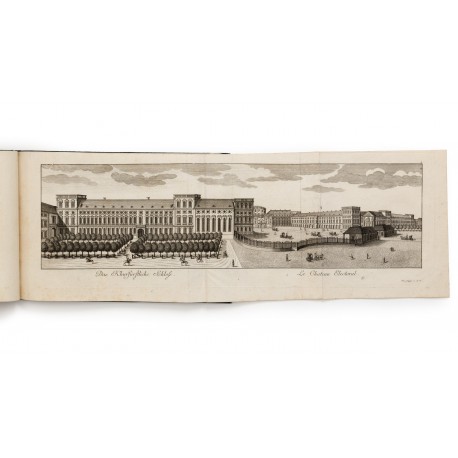Vues de Mannheim représentées sur vingt six planches dessinées d après nature par Jean François de Schlichten et gravées par les fréres Klauber à Augsbourg. Avec une explication des planches
- Subjects
- Book illustration - Artists, German - Klauber (Johann Baptist), 1712-1787
- Book illustration - Artists, German - Klauber (Joseph Sebastian), 1700?-1768
- Germany - Description and travel - Early works to 1800
- Authors/Creators
- Schlichten, Johann Franz von der, 1724-1795
- Artists/Illustrators
- Bibiena, Alessandro Galli, 1687-before 1769
- Klauber, Johann Baptist, 1712-1787
- Klauber, Joseph Sebastian, 1700?-1768
- Quaglio, Lorenzo, 1793-1869
- Schlichten, Johann Franz von der, 1725-1795
- Printers/Publishers
- Schwan, Christian Friedrich, active 1765-1786
- Other names
- Karl Philipp III, Kurfürst von der Pfalz, 1661-1742
- Karl Theodor, Elector Palatine and Elector of Bavaria, 1724-1799
Schlichten, Johann Franz von der
Mannheim 1724 – 1795 Mannheim
Vues de Mannheim représentées sur vingt six planches dessinées d’après nature par Jean François de Schlichten et gravées par les fréres Klauber à Augsbourg. Avec une explication des planches.
Mannheim, Christian Friedrich Schwan, 1782
oblong folio (240 × 345 mm), (7) ff. letterpress signed A–D2 (–D2, cancelled as usual) and paginated 1–14, plus twenty-six numbered engraved plates (one folding, the others full-page).
provenance Hartung & Hartung, Auktion 77, Munich, 2 November 1994, lot 927 — Hartung & Hartung, Auktion 119, Munich, 5 May 2008, lot 590
Title and margins of a few leaves faintly browned, otherwise in very good state of preservation.
binding nineteenth-century blue cloth over thin paper boards; spine lettered and bands decorated in gilt; pink endpapers, blue speckled edges.
A suite of twenty-six views documenting the extensive building programme carried out at Mannheim during its years as Electoral capital, 1720–1778. The plates were engraved by the Klauber brothers of Augsburg, Joseph Sebastian (1710?–1768) and Johann Baptist (1712–1787), from drawings by Johann Franz von der Schlichten, professor in the Mannheim Academy, and after 1751 ‘Court Painter’ and curator of the Electoral picture gallery,1 possibly assisted by the architect Franz Wilhelm Rabaliatti (1716–1782). ‘Dieser Ansichtenband ist der einzige, der ausführlich über das Aussehen einzelner Bauten in Mannheim des 18. Jahrhunderts informiert’.2
The unexpected transfer of the Palatinate court from Heidelberg to Mannheim in 1720 provided the court architect Alessandro Galli-Bibiena (1686–1748) with a series of important commissions, notably the Electoral Palace with its integral opera house, the largest Baroque complex in Germany (shown on folding plate 5). The sculptors Pieter Antonie von Verschaffelt, Gabriel Grupello, and Johann Paul Egell also benefited from the patronage of Kurfürst Karl Philipp. His successor, Karl Theodor, favoured the architect Lorenzo Quaglio (1730–1805), whose reconstruction of the National Theatre, remodelled from grain and fruit warehouses (shown on plate 22), was completed just as the Court was obliged to move to Munich.
Most buildings depicted in these views were damaged or destroyed during the Siege of 1795, or disappeared in the devastation of 1939–1945. Since other contemporary engraved views lack equal architectural detail, historians have often depended upon the present work for the original appearance or position of lost or damaged works.3
The book is of long-standing rarity – four facsimile editions have been published, in 1856, 1917, 1929, and 1959 – and thirteen copies only can be located by the writer in public collections (none in North America)
● Berlin, Staatsbibliothek zu Berlin – Preußischer Kulturbesitz, quer 4° Karten Abt. Y 30305 (‘Bestand erfragen / Kriegsverlust möglich’)4 ● Düsseldorf, Universitäts- und Landesbibliothek, 19 GUST 359(4) ● Fulda, Hochschul- und Landesbibliothek, quer KW D 28/53 ● Heidelberg, Universitätsbibliothek, BATT 25/2 FOL RES ● Karlsruhe, Badische Landesbibliothek, O74 B 5 ● London, British Library, 744.a.5 ● London, National Art Library, Victoria & Albert Museum, 15.GG.23 ● Mannheim, Reiß-museum, Mh 90765 ● Mannheim, Universitätsbibliothek6 ● Munich, Bayerische Staatsbibliothek, 4 Germ. sp. 300m ● Vienna, Landesbibliothek, C 98178 (Bibliothek Portheim) ● Weimar, Herzogin Anna Amalia Bibliothek, Th A 2: 19[a] ● Würzburg, Universitätsbibliothek, 35/A 22.32 (‘Titelseite und S. 1–14 fehlen’)
Since 1950, three other complete have been offered for sale in the German auction rooms;7 no copy is recorded in Anglo-American sale records since 1975.
reference Lebenslust und Frömmigkeit: Kurfürst Carl Theodor (1724–1799) zwischen Barock und Aufklärung, Katalog, edited by Alfried Wieczorek (Regensburg 1999), ii, pp.240–247 no. 4.4.10 (all plates reproduced from copy in Reiss-Museum, Mannheim, B Bass 181), 389–390 no. 5.6.17 (plate of Marktplatz from Reiss-Museum, Mannheim, G Ad 121 c, k)
1. Barbara Grotkamp-Schepers, Die Mannheimer Zeichnungsakademie 1756/1769–1803 (Frankfurt 1980), pp.143–147, 256.
2.Inge Gesche, in Lebenslust und Frömmigkeit (op. cit.), p.240.
3. Klaus Lankheit, for example, reprints Schlichten’s descriptive text for four views, and reproduces two plates (nos. 4, 9) in his monograph Der kurpfälzische Hofbildhauer Paul Egell (Munich 1988); five prints are discussed and one reproduced (as pl. 17) by Alexandra Glanz, Alessandro Galli-Bibiena (1686–1748): inventore delle Scene und Premier Architecteur am kurpfälzischen Hof in Mannheim; ein Beitrag zur Bibiena-Forschung (Berlin 1991).
4. Katalog der Ornamentstichsammlung der Staatlichen Kunstbibliothek, Berlin (1939), no. 2160.
5. Heinz Veitenheimer, Druckort Mannheim: Mannheimer Verleger und ihre Drucke von 1608 bis 1803 (Frankfurt am Main 1996), no. 997.
6. Formerly in the Wissenschaftlichen Stadtbibliothek Mannheim, utilised for the facsimile edition (with foreword by Gustav Jacob) Das kurpfälzische Mannheim 1782: eine wichtigsten Bauwerke zur Zeit der Uraufführung von Schillers ‘Räubern’ (Mannheim: Bibliographisches Institut, 1959), and since 1971 subsumed in Universitätsbibliothek Mannheim.
7. ● Tenner, Auktion 46, Heidelberg, 19 May 1965, lot 1137 (dm 1000) ● Tenner, Auktion 100/i, Heidelberg, 8 May 1974, lot 1942 (dm 6350) ● Zisska, Schauer & Co. KG, Munich, Auktion 63, 7–9 May 2014, lot 1586. An incomplete copy (24 of 26 plates) was sold in Tenner, Auktion 109, Heidelberg, 4 May 1976, lot 2207 (dm 1500).










